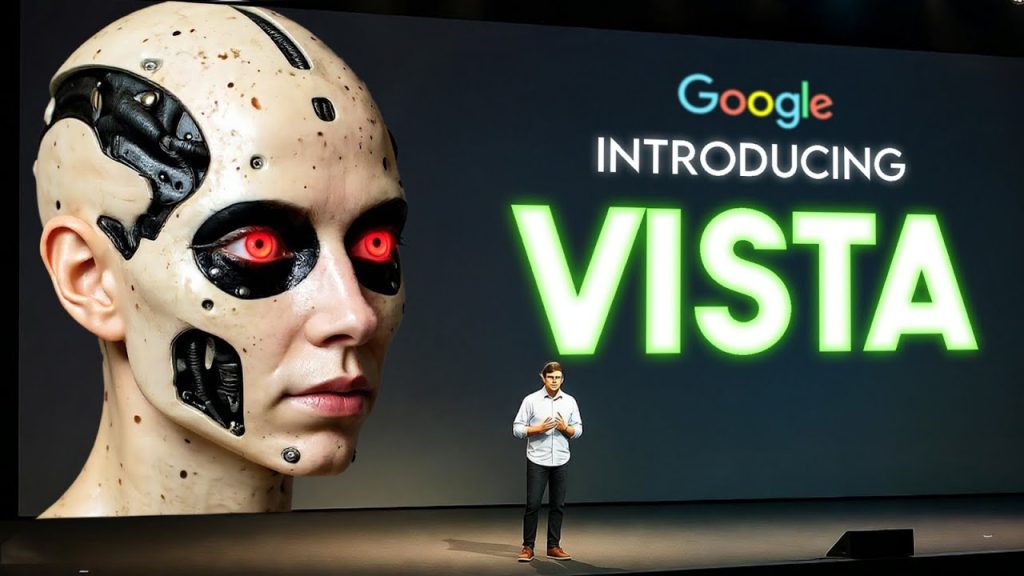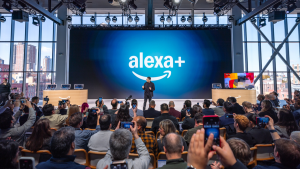Google Launches VISTA: An Advanced AI Video Generation Agent Surpassing VEO 3.

Google’s Vista: A New Era in AI Video Creation
Google has unveiled Vista, an innovative AI model that revolutionizes the way videos are generated. Unlike traditional models that require extensive retraining and fine-tuning, Vista optimizes its performance in real-time. By learning from its mistakes and automatically rewriting its own prompts, Vista not only improves its video outputs but also surpassed Google’s previous top model, V3, with a remarkable win rate of 60%. This marks a significant shift towards self-evolving AI video creation.
How Vista Works
The mechanism behind Vista is both sophisticated and structured. It starts with your video idea, dissecting it into a detailed plan broken down scene by scene. Each scene encompasses nine distinct properties, including:
- Duration
- Scene Type
- Characters
- Actions
- Dialogues
- Visual Environment
- Camera Work
- Sounds
- Mood
This detailed approach contrasts sharply with standard video prompt generators, where users often simply input a prompt and hope for the best. Vista creates a comprehensive roadmap of what needs to happen and when, setting it apart from its competitors.
Tournament-Based Evaluation System
Vista subsequently generates multiple video candidates and evaluates them using a unique tournament-based system. This involves head-to-head comparisons where videos go against each other, and the most effective ones progress to the next round. A key aspect of this evaluation process is the generation of “probing critiques” for each video before comparisons are made. This allows the AI to analyze each video critically, leveraging these insights for fairer evaluations.
Once the best candidate is identified, it is subjected to a thorough review by a three-judge panel focusing on visual, audio, and contextual elements. This “jury” system consists of:
- A normal judge for general scoring.
- An adversarial judge looking for flaws.
- A meta judge synthesizing both evaluations.
This multi-faceted approach is designed to catch nuances and issues that a singular perspective might overlook.
Detailed Evaluation Metrics
The evaluation metrics are meticulous. For the visual aspect, judges consider factors such as:
- Visual fidelity
- Motion dynamics
- Temporal consistency
- Camera focus
- Visual safety
For audio, they focus on:
- Audio quality
- Alignment between audio and video
- Audio safety
In terms of context, the criteria include:
- Situational appropriateness
- Semantic coherence
- Text-video alignment
- Engagement
- Natural transitions
After evaluations, Vista utilizes a deep thinking prompting agent to refine and rewrite its prompts through a six-step reasoning process. This includes identifying weaknesses, clarifying expected outcomes, assessing prompt detail, and making targeted modifications. Consequently, a new cycle of video generation begins.
Iteration and Performance Metrics
Vista operates through several iterations, completing one initialization round followed by four self-improvement loops. Each iteration generates numerous video variations—30 per round—through multiple rounds of testing, allowing Vista to systematically enhance its outputs.
The benchmarks for Vista are impressive. In testing across two data sets—one with single-scene prompts and another multi-scene set—Vista outperformed direct prompting significantly. By the fifth iteration, it achieved winning rates of approximately 46% across both data sets, indicating a substantial gap of 32% to 35% between its wins and losses.
Robust Optimization Compared to Other Models
Furthermore, Vista was tested against other optimization methods like Visual Self-Refine and Google Cloud’s Rewrite tool. While those methods produced mixed results, Vista maintained consistent improvement across iterations, demonstrating its capacity for genuine learning.
In comparison to competing models, Vista won 66.4% of evaluations conducted by experts in prompt optimization. When assessed on a scale of 1 to 5, Vista averaged 3.78, while the next best model only reached 3.33. It significantly improved visual quality scores from 3.36 to 3.77 and audio quality from 3.21 to 3.47.
Addressing Challenges in Video Generation
Vista also tackles common challenges faced in video generation, such as hallucinations—where the model produces unexpected elements. The model mitigates this risk by enforcing strict constraints during its planning phase and applying penalties for violations during the selection process. For example, it only includes captions, background music, or voiceovers if specifically requested.
In practical applications, Vista demonstrates improved instruction adherence, successfully generating complex scenes that previous models struggled to produce accurately. This translates to a more usable and coherent video output, paving the way for various applications across sectors such as media, marketing, and education.
A Step Forward in Test Time Optimization
The launch of Vista aligns with a broader trend in AI research known as test time optimization. This approach pivots away from traditional methods of training larger models and focuses on optimizing outputs during the inference phase. As AI technology continues to evolve, Vista represents the first black-box, test-time prompt optimization framework for video generation.
Limitations and Future Prospects
Despite its groundbreaking capabilities, Vista does have limits. It relies on multimodal large language models as judges, which can introduce some bias, although human evaluations help counterbalance this issue. As the underlying models improve, so will Vista’s performance, limiting its magic-like potential.
The results are already remarkable—having bested V3 in 60% of all tests and showing consistent enhancement across iterations provides a glimpse into how AI video creation might evolve.
Conclusion
With the advent of self-optimizing video generation, Vista not only slashes production costs but also accelerates workflows and scales content creation in unprecedented ways. As we look toward the future of AI in video production, the question remains: Are we witnessing the dawn of a major transformation in how content is created and consumed, or just the initial step into something much more significant? Share your thoughts in the comments below.
#Google #Unveils #VISTA #SelfImproving #Video #Gen #Agent #Outperforms #VEO
Thanks for reaching. Please let us know your thoughts and ideas in the comment section.
Source link






👉 Unlock your proactive AI teammate now: https://proactor.ai/
Google is far ahead of OpenAI and I feel that OpenAI will have to be consumed by Microsoft to save them from going bust. That 'adult-theme' AI is not going to be any good unless it is really depraved…like DJT!
only issue i see is the name beeing vista as microsoft already used that and idk if they will have issues with that name
Nice
Yes but Vista must use significantly more energy than Veo. 20 times bigger cost for 30% increase of quality.
Sounds like it's gonna be expensive monetary and computational.
😅
This is going to be pretty useful longer term, just to automatically dump the right tricks into different video prompts.
Windows Vista, what could go wrong…
Wow, VISTA sounds like a full AI Movie Studio.
It's a very great surprise from VEO and Google
The question is: when will they add it to Google Flow, Veo 3, or Gemini for users to test and use?
This is definitely a great improvement because, even if you do not have the perfect prompt, Vista will help you get the output you actually wanted the first time and, therefore, save time.
Don't mean shit to me if I don't have access
Now: Google Vista
NEXT: Google 10 and Google 11
explain "penalize" in this usage
9:27" The wheels of the gremlin train are off the track. Video accepted?
Sounds like huge waste of compute for cat Videos….
so we have chatGPT vistra webbrowser, VISTA ai video agent and suno v5 now.. all those ai tools, ai is evolving so fast
Finally, can't wait for the anti-AI people to stop whining so much about "slop"!!!
Accelerate!!!
So much technology, shackled by "anti-discrimination" laws.
They added an agent that is prompted “make it better”
Original avatar android didnt move, second model moved too much. Latest does not move. Maybe, finding a middle ground, like moving naturally as we speak will be enough. Does not to be walking or posing as a model. Just a "guy" talking and moving the arms naturally as we all do without overdoing it.
Full-length high quality AI movies before GTA 6.
1:55 – Interesting there's a similar process in the human cell, that weigh in 'orders' from the body.
I’m a music producer, and honestly, I hate AI-generated music because I’m used to having full control over every step of the creative process. With something like Suno AI, you just write a prompt and hope for the best. But if an AI music generator actually gave me more control, like this — so I could really shape what I hear in my head — I might be a bit more tempted to play around with it.
This is very promising because we created LLM models by basically growing them systematically, so setting up new forms of doing that in new ways is a good direction. That said, it's expensive as hell to do right now. This seems great for pushing the boundaries of creative multimodals to create deeper, correct outputs for future models to be trained on and raise the base level of all creative models in the future. Also, because of the new abstract reasoning methods using vision and audio to reduce computation by 60-80% in some tasks being worked on right now, we can expect this to become much cheaper to run and outputs to become much stronger since the computational phase of AI thinking is actually based in multimodal content instead of words and tokens. Vision + Audio thinking should transfer incredibly well to creative workflows after all.
All this new aai technology is so confusing because its moving at a fast rate 😮😮
Why would ANY software company use the name Vista after “Windows Vista” ffs just use Google Translate and find something saucy.